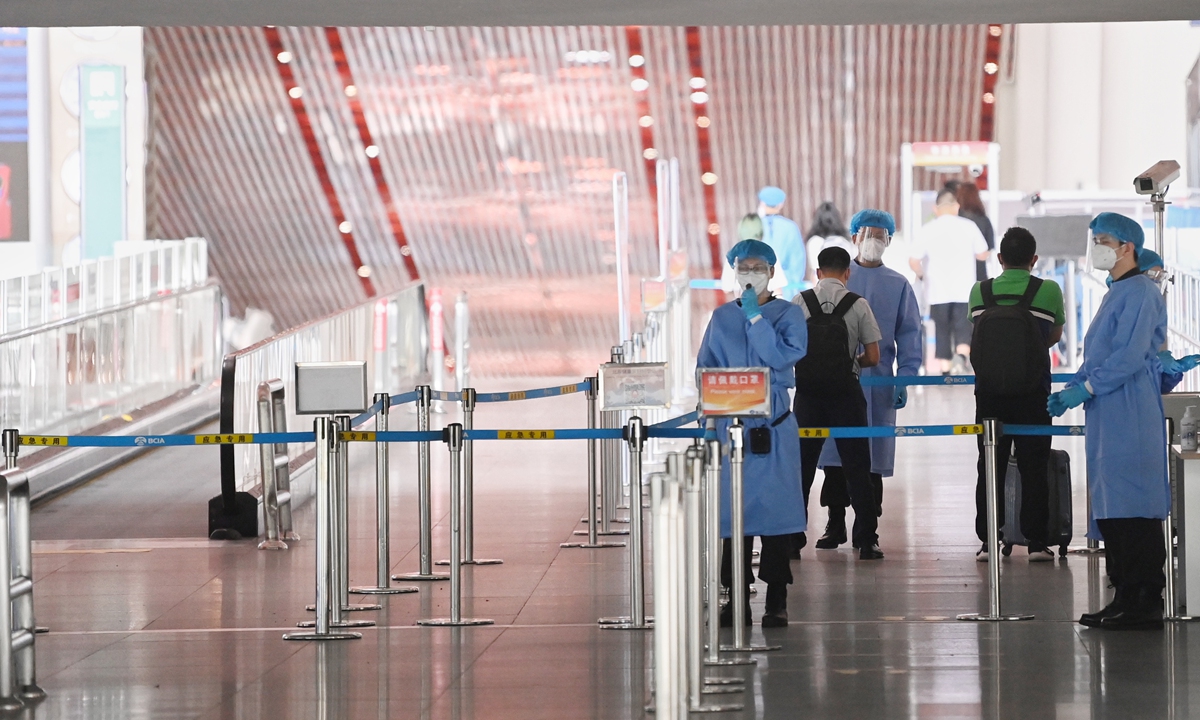Chinese airlines looking at another year in the red
Pandemic and low-season push down demand

Internal view of Beijing International Airport on August 9 Photo: IC
This year's National Day holidays could be regarded as the last profitable small peak window for airlines. Observers believe that airline performance over the last three months of this year is heavily dependent on last week's National Day holidays, but there have been few optimistic voices across the industry so far.
The facts suggest that Chinese airlines in the fourth quarter of this year may see another round of bleeding, dragging down the entire year's performance.
"The fourth quarter performance of Chinese airlines industry could be very tough, and the whole year's industry loss could be as high as 30 billion yuan ($4.65 billion)," Lin Zhijie, a market watcher predicted on Wednesday.
In 2020, China's three largest carriers, Air China, China Eastern Airlines and China Southern Airlines recorded a combined loss of 37.1 billion yuan.
He said the loss is due to the localized COVID-19 outbreaks over recent months, such as the Nanjing, East China's Zhejing Province, Harbin in Northwest China's Heilongjiang Province and Ili in Southwest China's Xinjiang Uygur Autonomous Region, which have served to drag down enthusiasm amongst travelers.
In addition, the aviation market will enter the traditional off-season after the National Day holidays, and the fourth quarter of each year is also the season with the largest losses for airlines throughout the year.
For example, before the emergence of the pandemic in 2019, Air China lost 350 million yuan in the fourth quarter, with China Eastern Airlines and China Southern Airlines each losing more than 1 billion yuan.
Data from the Ministry of Transport reveals that from October 1st to 7th, China saw a total of 403 million passenger trips, an average of 57.5 million passengers trips per day, an average daily decrease of 33.9 percent compared to the same period in 2019, and down 7.5 percent than the same period of 2020.
Among them, civil aviation accounted for 9.31 million passengers, an average of 1.33 million passengers per day, an average daily decrease of 26.9 percent compared with the same period in 2019, and an average daily decrease of 19.7 percent compared with the same period in 2020.
Data released by the Civil Aviation Administration of China (CAAC) showed that the average passenger load factor during the October 1-7 was 73.7 percent, a decrease of 4.8 percentage points from 2020.
CAAC said due to the recent outbreaks of new cases in some parts of the country, the number of inbound and outbound passenger bookings and passenger load factors in most tourist cities during the holidays were slightly lower than the same period last year.
The individual areas referred by CAAC included Southeast China's Fujian Province, where the pandemic spread from the Mid-Autumn Festival onward. It was not until 9:00pm on October 7 that Xiamen announced that the city's medium- and high-risk areas were "cleared", and Fujian Province returned to being classified as a low-risk area.
Then came Xinjiang during the National Day holidays. On October 3, a routine nucleic acid test in Khorgas city, Ili Kazakh Autonomous Prefecture, Northwest China's Xinjiang Uygur Autonomous Region, found that two people had positive nucleic acid test results. Both were all asymptomatic patients.
Tourists traveling in Ili Prefecture were preventing from leaving pending the results from nucleic acid testing; other areas in Xinjiang also immediately increase the implementation of control policies.
The unexpected COVID-19 resurgence in Xinjiang during the National Day holidays, China's traditional travel peak, stranded and upset many tourists in the region, one of the most popular travel destinations.
Prior to this, industry insiders predicted that the aviation market was on a positive path in the second half of the year, mainly due to the stronger spread of Delta virus and frequent outbreaks in various regions.
Since the localized outbreak in Nanjing, East China's Zhejiang Province in July, prevention and control policies in various regions have also become stricter and have had a direct impact on travel confidence.
The International Air Transport Association on October 4 announced its latest outlook for airline industry financial performance showing improved results amid the continuing COVID-19 crisis.
It said net industry losses are expected to reduce to $11.6 billion in 2022 after a $51.8 billion loss in 2021. In total, total industry losses in 2020-2022 are expected to reach $201 billion.


